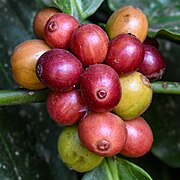Infructescence (fruiting head) is defined as the ensemble of fruits derived from the ovaries of an inflorescence. It usually retains the size and structure of the inflorescence.[1]
In some cases, infructescences are similar in appearance to simple fruits. These are called multiple fruits. One example is the infructescence of Ananas, which is formed from the fusion of the berries with receptacle tissues and bracts.[2][3]
The mature infructescence of a grain, such as wheat or maize, is known as an ear. The infructescence of Ficus is called a syconium.[4]
References
[edit]- ^ "infructescence", The Free Dictionary, retrieved 2022-03-18
- ^ "Multiple Fruits, Pineapple Multiple Fruit, Examples of Multiple Fruits, Types of Multiple Fruits". www.fruitsinfo.com. Retrieved 2022-03-18.
- ^ "Multiple Fruits". science.jburroughs.org. Archived from the original on 2022-01-08. Retrieved 2022-03-18.
- ^ "Definition of SYCONIUM". www.merriam-webster.com. Retrieved 2022-03-18.




Well, that’s interesting to know that Psilotum nudum are known as whisk ferns. Psilotum nudum is the commoner species of the two. While the P. flaccidum is a rare species and is found in the tropical islands. Both the species are usually epiphytic in habit and grow upon tree ferns. These species may also be terrestrial and grow in humus or in the crevices of the rocks.
View the detailed Guide of Psilotum nudum: Detailed Study Of Psilotum Nudum (Whisk Fern), Classification, Anatomy, Reproduction